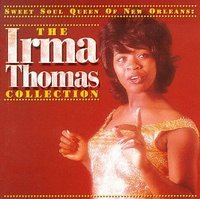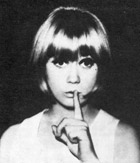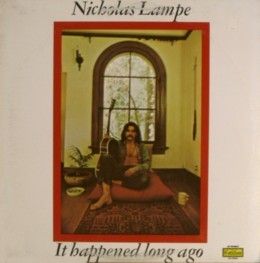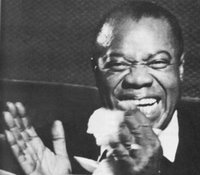There are a lot of
Northern Soul compilation CDs about these days (I'm a bit addicted to them myself), along with
Northern Soul websites and
Net radio shows.
'Northern Soul', though, is a curious musical classification. Newcomers have trouble getting a handle on it, and even those immersed in it can struggle with a definition.
As Simon White of the
Metropolitan Soul Show put it in a recent thread at the
Spectropop Group,
The Northern Soul Scene is a law unto itself and frankly you either understand it or you don't. (Spectropop Message #3346, 12 Feb 06)
Dave Monroe bravely offered a
menu of characteristics: four-on-the-floor beat, upbeat tempos, "uplifting" lyrics..., strings, "soul bells" et al, but added:
I might not be able to tell you what it is, but I know it when I hear it. Interestingly, the problem of defining Northern Soul always seems to lead us back to medieval philosophy. (#3368, 13 Feb)
For a start, Northern Soul isn't called 'Northern' for being recorded in the North of anywhere: a lot of it happens to have been recorded in the north of the US, but that's a red herring. Southern Soul, yes, might be soul music recorded in the south of the USA, but Northern Soul isn't its opposite.
In fact, Northern Soul can include soul from the Southern states, for example by New Orleans singer Irma Thomas or from the Memphis soul label Stax.
This is because in 'Northern Soul' the 'Northern' means the North of
England, where its fan base originated, and the term wasn't coined until about 1970. In other words, a lot of Northern Soul music was recorded by artists who had no idea they were recording Northern Soul.
 New Orleans: that'd be Southern, right? Also appearing on 26 Stonking Northern Soul Greats!
New Orleans: that'd be Southern, right? Also appearing on 26 Stonking Northern Soul Greats!
What's more, oddly enough, it isn't all soul. Most of it is indeed soul or soul-inspired pop, and you'll find Motown and Stax and their imitators, but you'll also find catchy, maybe danceable (maybe not) pop music, often with stirring brass arrangements but still pop.
Northern Soul is also noted for overlooked tracks, often by obscure artists, hence the related term Rare Soul, but this is more a matter of availability than musical style. One of the delights of playing a well-chosen Northern Soul collection on CD is the discovery of marvellous songs rescued from oblivion. But once again, this needs qualifying: you'll also find well-known songs and artists on Northern Soul compilations.
In fact, as soon as you offer a definition, you need to qualify it. You might try, for example,
uptempo, danceable soul by black American singers. Qualify!
The artists are usually, but not necessarily, black, and not always soulful: I've seen
The Four Seasons' The Night and
Gary Lewis's My Heart's Symphony on Northern Soul collections (yes, soul is a relative term, but Gary Lewis?).
And not always singers: you'll also find a scattering of instrumentals, some of them funky, or soulful in the Booker T & the MGs way, but some of them sound more like background music to a party scene in a teenage movie from the 60s.
Lynne Randell gets a Northern Soul guernsey for
Stranger In Your Arms, a wonderful song, but it's more in the area of classy pop than soul, and the singer is a white, blonde Australian (okay, born in the UK, recorded in New York, but an Aussie nevertheless). David Bell (
Spectropop #3368, 13 Feb), puzzles over the inclusion of an obscure Connie Francis B-side
It's Gonna Take Me Some Time, and concludes:
It seems that every singer has recorded at least one Northern Soul side.
 Lynne Randell: Northern? Soul?
Lynne Randell: Northern? Soul?
Uptempo or danceable? ACE's
Once Upon A Time In Wigan CD includes Fats Domino's
It Keeps Rainin', a pleasant little foot-tapper, but hardly music to rage to. On the danceability of Northern Soul, Julio Niño comments:
personally I can´t always dance to them or don´t always feel like dancing to them. (
Spectropop #3330, 13 Feb).
In fact, Northern Soul isn't one "style of music" at all (as early versions of the
Wikipedia article had it; now amended). It's an umbrella term for a number of styles, and some of the songs you find there can be surprising. That's because, in its strictest sense, a Northern Soul track is one that was popularised by a deejay at a northern English dance venue. So if a deejay liked Dusty Springfield's
What's It Gonna Be, he played it, and if it went down well, it became 'Northern Soul', something that would've been news to those associated with putting the record out in the first place.
As Howard Earnshaw notes:
In the 70s the overriding feature of a 'northern soul' record was the 4x4 beats, and uptempo was the key. Nowadays the scene is divided into various sub-sections, with ALL tempos of soul being played at various venues. Not only that, there is R&B (sometimes as early as 1960), Modern Soul up to the present, Crossover, 70s/80s, New 6Ts, Oldies, etc. etc. (
Spectropop #3368, 13 Feb)
It's usually agreed that
Dave Godin (1936-2004) , the critic, anthologist and label owner, coined the term 'Northern Soul' around 1970, when he noticed that Northerners visiting his record shop in London were seeking out a unique range of obscure American soul 45s. Thus, from the start, the term owed itself to a social phenomenon, an aspect of consumer demand, rather than to a strict musical classification.
According to Simon Frith and Tony Cummings ("Playing Records", reprinted in
The Beat Goes on: The Rock File Reader, 1996) the soul boom of the 60s, started in London by the mods, had fizzled out in the south of England by the late 60s , but it persisted in the north and thrived into the 70s, where it supported the famous allnighter dance venues, places like the
Wigan Casino and the
Blackpool Mecca. While the rest of the world moved on to progressive rock and psychedelia, and American soul itself turned funkadelic, Northerners continued to seek out increasingly obscure soul tracks to keep up the supply of old-style stomping soul.
Eventually, music was recorded especially for the Northern Soul market, but the term was initially applied retrospectively, and it was applied to anything that had become familiar to the patrons of the northern clubs. Thus, what we're looking at here is a social movement as much as a musical genre.
('Northern Soul' isn't the only retrospectively applied musical genre: for example I doubt that the numerous orchestra leaders and crooners listed at the excellent
Space Age Pop website realised they were contributing to the Lounge, Exotica or Space Age repertoires.)
In my own recent rant about terminology (
Spectropop #3323, 11 Feb) I wondered whether a newcomer might be misled by the mistaken belief that they are approaching a specific genre called Northern Soul, a recognisable style in the manner of ska or rockabilly or bebop. Although seeking out Northern Soul will put you in touch with some lost soul gems, you wouldn't want to neglect other rare soul reissues from a label like Kent/Ace. They might not have 'Northern Soul' written all over them, but they'd probably be in the area you're interested in.
Finally, Phil X. Milstein added this to the discussion at Spectropop:
I'm far from any kind of NS expert, but for my own purposes I've always gone by the rule of thumb that: bari sax included, Northern Soul; no bari, no Northern Soul (
Spectropop #3323, 13 Feb).
See follow-up post.
I'm not sure that this theory holds up, but then I'm not sure that it's meant to!
...................................................................................................
This post refers to a thread at the Spectropop Discussion Group, one of the most informed and civilised music forums on the Net. It's at Yahoo! Groups (free registration required), or go there via Spectropop's main website.











